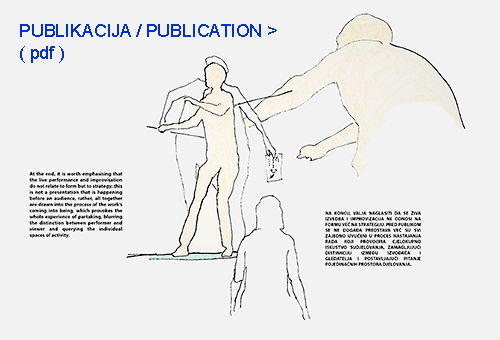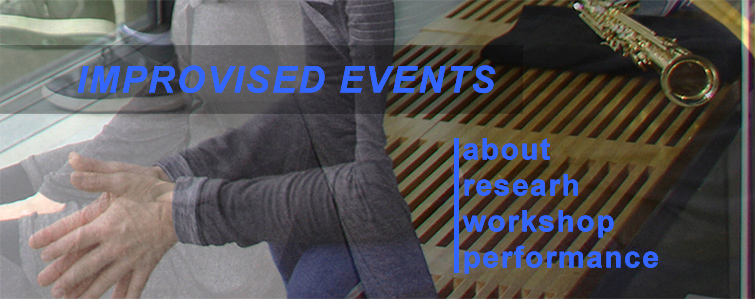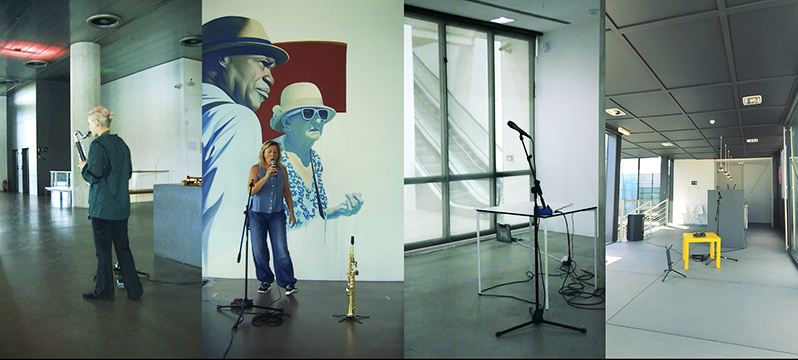/ about the performans in MSU
The project Improvised Events has been produced as the visual, dance, instrumental and vocal interaction of four women artists: Andreja Kulunčić (visual artist), Zrinka Užbinec (dance artist and choreographer), Jasna Jovićević (saxophonist and composer) and Annette Giesriegl (vocalist). It is a site specific performance designed for the Museum of Contemporary Art, that is, for its central vertical space the Baunet Café, the architecture of which links the storeys and spaces of the museum. But since this space has never really been operationalised, the linkage with and interference of the spaces of the museum has remained at the level of idea and notion. The performance Improvised Events and the exhibition that has been produced as a result of it endeavour to react precisely to this spatial and atmospheric vacuity of the museum. The four artists, using their own individual media – video, sound, voice and movement and in interaction with the audience activate the architecture and set-up of the museum, that is, mobilise the fundamental components of the museum structure: artists, work, public, collection, space and architecture.
The basic structure of the work is set up and agreed on beforehand, the performers improvise on it in a dialogue with each other, in a dialogue with the space and in a dialogue with the visitors. There are four stations, each consisting of a looper, a microphone and a speaker, on which during the performance the vocalist and the instrumentalist change places in recording loops to be heard during the performance and to which they and the dancer react with improvisations. The performance starts in the foyer of the museum with a bass clarinet solo that sets up a minimalist foundation on which the following musical performance subsequently draws. During this time, in the outer part of the museum, apart from the audience and the music being played, the dancer fills the space with her body in a solo performance. After that come a series of performances that are constructed spatially and end with a section on the roof of the museum. During the performance an instantly created composition is built up. At the end it is connected up, and when it passes on its return through the same space, the audience becomes aware that the composition that they have heard, together with traces of the performance that it sees, is a kind of acoustic sculpture, a work that created in its previous passing though the museum, in the interaction of the performers – sound, image, voice, movement - and the audience.
Within the dance part of the project, the body has got its own line in which it creates awareness of sensations, the invisible structures of the space, sounds, the dynamics of movement of the audience. The dance imaginarily fills up the voids, building an invisible network.
Along with sound and movement, video is the third component of the structure. If sound and movement, provisionally put, fill up the space, video is the element of time. The videos, that is, offer the public an analytical view of the work and an insight into the parts of the project that cannot be followed all at the same time because of the constant alternation of positions.
At the end, the role of the public should not be neglected. On the one hand, sharing the space with the performers, the public has an active part in the construction of the installation. On the other, with the choice of its positions, movement, or by focusing on one of the simultaneous segments, the public manages its own perception. In addition, some of the people from the public are invited to follow a different performance route with the task of observing the behaviour, retaining the attention and movement of the audience during the performance. Half way through they move away from the rest of the audience, come into the space of the permanent display divided from the area of the Baunet Café by glass panels. From there they observe the further course of the performance, but do not hear anything, their attention being transferred to the behaviour of the public. With glass marker pens they draw the movements of the audience, the density of its lingering at a given spot, the focus of attention or write words that describe these things. The performers on the other hand use these notes as choreographic instructions and graphic notations for further actions. In this sense, then, this part is the climax in which all become both performers and audience and in which the spatial lines of force of the museum are collected.
At the end, it is worth emphasising that the live performance and improvisation do not relate to form but to strategy; this is not a presentation that is happening before an audience, rather, all together are drawn into the process of the work’s coming into being, which provokes the whole experience of partaking, blurring the distinction between performer and viewer and querying the individual spaces of activity.
Text by Irena Bekić
The concept for the project was designed by visual artist Andreja Kulunčić, music by vocalist Annette Giesriegl and saxophonist Jasna Jovićević, choreography and performance by Zrinka Užbinec.
The work was produced and organized by Andreja Kulunčić, MAPA.
The project curator is Jasna Jaksic, MSU.
Zagreb, 2019.

: IZLOŽBA / IZVEDBA
IZLOŽBA IZVEDBE
Muzej suvremene umjetnosti Zagreb
Kustosica Jasna Jakšić/MSU
14. i 16. rujan 2019.
Projekt „Improvizirani događaji“ realizira se kao vizualna, plesna, instrumentalna i vokalna interakcija četiriju autorica: Andreje Kulunčić [vizualna umjetnica], Zrinke Užbinec [plesna umjetnica i koreografkinja], Jasne Jovićević [saksofonistica i skladateljica] i Annette Giesriegl [vokalistica].
Radi se o site specific izvedbi osmišljenoj za Muzej suvremene umjetnosti, odnosno njegov središnji vertikalni prostor Baunet caféa koji arhitekturom povezuje etaže i prostore muzeja. No kako taj prostor nikada nije doista profunkcionirao, povezanost i interferencija prostora muzeja ostala je na idejnoj razini. Izvedba „Improvizirani događaji“, odnosno jednokratna izložba koja nastaje kao njezin rezultat, nastoji reagirati upravo na prostornu i atmosfersku ispražnjenost muzeja. Četiri umjetnice s pomoću medija kojim se koriste – videom, zvukom, glasom i pokretom te u interakciji s publikom aktiviraju arhitekturu i postav muzeja, odnosno pokreću temeljne sastavnice muzejske strukture: umjetnici/e, rad, publika, zbirka, prostor i arhitektura.
Osnovna struktura rada je postavljena i unaprijed dogovorena, a na nju izvođačice improviziraju u dijalogu jedna s drugom te u dijalogu s prostorom i posjetiteljima. Radi se o četiri stanice, od kojih se svaka sastoji od loopera, mikrofona i zvučnika, na kojima se tijekom izvedbe izmjenjuju vokalistica i instrumentalistica u usnimavanju matrica koje se čuju tijekom izvedbe i na koje i one i plesačica reagiraju improvizacijama. Tako izvedba započinje u foajeu Muzeja solom na bas klarinetu koji postavlja minimalističku osnovu na koju se kasnije naslanja sljedeća glazbena izvedba. Za to vrijeme plesačica u vanjskom dijelu muzeja odvojena od publike i od zvuka instrumenta tijelom popunjava prostor solo izvedbom. Nakon toga slijedi niz izvedbi koje se grade prostorno i završavaju dionicom na krovu Muzeja. Tijekom izvedbe gradi se trenutačno stvarana kompozicija koja se na kraju povezuje te, prolaženjem u povratku istim prostorom, publika postaje svjesna da je kompozicija koju čuje zajedno s tragovima izvedbe koje vidi, svojevrsna zvučna skulptura, rad koji se stvarao u prethodnom prolasku kroz Muzej, u interakciji izvođačica – glasa, slike, zvuka, pokreta – i publike.
Unutar plesnog dijela projekta tijelo ima vlastitu liniju osvještavanja senzacija, nevidljivih struktura prostora, zvukova, dinamike kretanja publike. Ples imaginarno popunjava praznine, gradeći nevidljivu mrežu.
Uz zvuk i pokret, video je treća sastavnica strukture. Ako zvuk i pokret, uvjetno rečeno, popunjavaju prostor, video je vremenski element. Video snimke, naime, pružaju publici analitički pogled na rad te uvid u dijelove projekta koje nije moguće pratiti u isto vrijeme s obzirom na stalnu izmjenu pozicija.
Na kraju, ne treba izostaviti ulogu publike koja s jedne strane, dijeleći prostor s izvođačicama aktivno sudjeluje u gradnji instalacije, a s druge, odabirom svojih pozicija, zaustavljanjem, kretanjem ili usmjeravanjem pažnje na neki od simultanih segmenata upravlja vlastitom percepcijom. Usto, nekolicina ljudi iz publike pozvana je da slijedi drugačiju rutu izvedbe sa zadatkom promatranja ponašanja, zadržavanja pažnje i kretanja publike tijekom izvedbe. Oni se na polovini rada izdvajaju od ostatka publike, dolaze u prostor stalnoga postava odijeljenog od prostora Baunet caféa staklenom stjenkom. Odatle promatraju daljnji tijek izvedbe, ali ne čuju te se njihova pažnja prebacuje na ponašanje publike. Markerom za staklo ucrtavaju putanje kretanja publike, gustoću zadržavanja, usmjeravanje pažnje ili pišu riječi koje je opisuju. Izvođačice će pak ove bilješke koristiti kao koreografske instrukcije i grafičke notacije za daljnju izvedbu. U tom je smislu ova dionica klimaks u kojemu svi postaju izvođači i publika i u kojoj se sabiru prostorne silnice Muzeja.
Na koncu, valja naglasiti da se živa izvedba i improvizacija ne odnosi na formu već na strategiju. Pred publikom se ne događa predstava već su svi zajedno uvučeni u proces nastajanja rada koji provocira cjelokupno iskustvo sudjelovanja, zamagljujući distinkciju između izvođača i gledatelja i postavljajući pitanje pojedinačnih prostora djelovanja.
Tekst Irena Bekić
Koncept projekta osmislila je vizualna umjetnica Andreja Kulunčić, glazbeni dio vokalistica Annette Giesriegl i saksofonistica Jasna Jovićević, koreografiju i izvedbu plesnog dijela Zrinka Užbinec.
Rad je producirala i organizirala Andreja Kulunčić, udruga MAPA.
Kustosica projekta je Jasna Jakšić
Zagreb, 2019.

